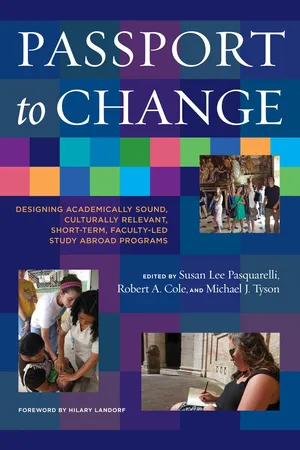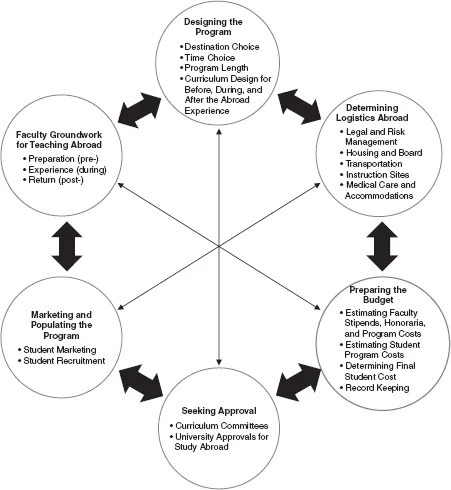![]()
PART ONE
UNDERSTANDING THE NATURE OF FACULTY-LED STUDY ABROAD PROGRAMS
![]()
1
SURVEYING THE LANDSCAPE
The Process of Developing Faculty-Led Programs
Robert A. Cole
It is not difficult to understand the appeal short-term study abroad programs hold for students and faculty leaders alike. As Herbst (2011) indicates in reference to the students he has taken to Istanbul, Turkey, on several occasions, “Unbound by their usual social networks and routines back home, students bonded as a tight-knit learning community in a way that is hardly possible on campus” (p. 224). And for himself, he states, “There has never been a teaching experience so intensely rewarding” (p. 225).
In my role as vice provost for global and international programs at Roger Williams University, I often hear similar heartfelt comments from faculty when they return from a successful short-term program abroad. Perhaps one of the most creative activities in my university role is observing and mentoring faculty as they develop from conception to fruition a broad array of faculty-led programs. This chapter is intended to help a faculty developer shape ideas scratched on a notepad into an organized, thoughtful program ready for launching. For those who already lead short-term programs, the contents may open new ways to think about program design and delivery. Moreover, this chapter provides a preliminary litmus test for faculty members to decide if they wish to forge on with the hard work of developing and delivering an academically sound, culturally relevant faculty-led program or retool an existing program. The topics included in this chapter lend faculty leaders the yardstick to measure their own tolerance for ambiguity, crises management, and program leadership.
Figure 1.1 illustrates our conception of the nonlinear touchpoints of program development for faculty-led short-term programs.
As readers see in the figure, arrows indicate multidirections of where to go after determining the substance of each touchpoint. Because of the nature of using an iterative program development process, faculty designers will find it necessary to revise a touchpoint as each design element is added. We found the best approach to our program design is to consider each thematic touchpoint, moving forward, backward, and crossing as each touchpoint is reconsidered in light of new thinking.
Figure 1.1. Touchpoints of program development: The iterative process of creating and implementing a faculty-led study abroad program.
Using the touchpoints of program development as a topical outline for this chapter, I begin with the first circle: designing the program.
Designing the Program
Destination Choice
Perhaps the best approach to selecting a faculty-led program destination is a backward design of the study abroad program curriculum so that it is not forced onto a site. The destination should be an organic or natural choice that fulfills the study abroad program’s outcome and, to an extent, stands as the sine qua non of the whole experience. In other words, without that chosen site, the curriculum as designed has little chance of being academically sound and culturally relevant (see Chapter 2 for an in-depth discussion on the fundamentals of an academically sound, culturally relevant curriculum).
So, does backward design mean choosing a content topic and then searching for a field site where students can experience that topic? Or does it mean choosing a field site and then deciding what kind of content to build around that site? Unsurprisingly, the answers are yes and yes. Tacking back and forth between potential field sites and possible topics is one of the many iterative tasks that define the process of program development.
For example, suppose a professor of American studies has expertise in the American themes of liberty, equality, justice, and revolution. He or she might well decide that a powerful experiential curriculum could be built around Paris by developing a program anchored in the concepts of liberté, égalité, et fraternité, the national motto of France. Such a program could bring into relief for U.S. students questions about how these concepts are enacted in everyday life after a revolution against the ruling powers.
Alternatively, my colleague Cliff Timpson, a professor of chemistry, and I developed a short-term program titled Beer as Chemistry, Craft, Culture, and Commerce. It is intended to teach students about the recent renaissance that artisanal industries are undergoing, specifically as illustrated by the craft beer movement. Beyond teaching students about the ingredients and processes for making beer, we find it important for them to understand the long history the product has as nourishment, social lubricant, currency, product of trade, and a source of tax revenue. To experience the sensibility in which beer is inseparable from cultural identity, few places abroad engender the type of understanding that is found in Germany and Belgium. Hence, our program moves among the German Rhineland, Brussels, and the Belgian countryside.
An unavoidable consideration for the destination choice is safety. A college or university with a vibrant study abroad office may have hundreds of students away during the course of a calendar year. This means that a university has a great deal of legal exposure at any given time, and if it sponsors faculty-led programs abroad, significant risks need managing. If an institution has a study abroad office, the director assists faculty in matching the school’s tolerance for risk with the ever-changing conditions of the field. However, a well-designed program implies that the developer has not only researched and considered the general level of security that prevails at the destination but also has taken into account the degree of risk in the daily itinerary as it relates to transportation, activities, people coming in contact with the students, and so forth.
Time Choice
In May and June the barley fields of the Poperinge district of western Belgium are knee high and getting taller each day. Likewise, the hop bines are inching up the training lines, and the cones are starting to emerge. To smell the agricultural air, to see the grain being malted, to understand beer from its earthy beginnings requires that our program be abroad as summer approaches in western Europe.
The optimum time for a faculty-led program abroad may be quite narrow, as is ours, or more likely open to a range of considerations. The school calendar is the principal driver of when programs can go afield. Typically, short-term programs are confined to the winter period between fall and spring semesters, spring break, or the summer period. Within these school calendar confines, the proposed course itinerary should be laid out tentatively to see if seasonal or weather concerns have an impact.
It might be tempting to imagine warm summer night dinners at the open-air cafés of Europe, or boating on the Thames, but keep in mind that London received more than 31 million visitors in 2015 (Coldwell, 2016). So it could be a long wait to tour the Tower of London, to say nothing of the crowded Tube. Meanwhile, August is when many Europeans go on holiday, so depending on the design of the study abroad program, key people or places may not be available.
Weather is another consideration as temperate conditions might make long hikes more bearable for one program but be the bane of another program that counts on the regularity of a tropical afternoon rain for students to make the observations the curriculum demands. The more flexibility that is built into the itinerary, while still meeting the learning goals, the less encumbered the design of the program will be in regard to the time of year it must be offered.
Program Length
In deciding how long to be abroad with your program, a number of factors need to be considered, including cost and timing. But a program’s proposed itinerary drives what is, arguably, the most important determinant for program length—the number of credits to be awarded.
The federal government’s definition of a credit hour (“Rules and Regulations,” 2010) is designed to ensure that students are engaged in the learning process for a period of time commensurate with the number of credits being awarded. The government takes license to define the quantity of learning that occurs because it provides students of most higher education institutions with federal student grants and loans. Meanwhile, regional accrediting bodies translate the government’s definition into the standards for colleges and universities to demonstrate that they are in compliance with the so-called coin of the educational realm—the credit hour.
The definition should not be seen as restricting what can be done with study abroad. Instead, it opens pathways to alternative, creative ways of thinking about how, when, and where students might engage in learning. For instance, lecturing for an hour 3 times a week for 15 weeks to students sitting in hard plastic chairs yields 45 hours of student engagement (if you accept that they are riveted to everything we might say during those lectures). Add to each lecture an estimated 2 hours of outside-the-classroom work by the student, such as reading, writing papers, and so on, yields another 90 hours of student academic engagement. Totaling inside-the-classroom to outside-the-classroom time, we arrive at the government’s magical number of 135 academic engagement hours to award 3 credit hours. The New England Association of Schools and Colleges Commission on Higher Education assumes a 50-minute hour, therefore the formula for arriving at the required number of engagement hours and days in the field is summarized in Table 1.1.
The government does not bind us to only one approach to teaching and learning, wherein one hour of classroom and a minimum of two hours of out-of-class work over a 15-week semester or trimester earns a credit hour for the student. Shaped in their thinking by the U.S. Department of Education and multiple contributors, the authors of the definition (“Rules and Regulations,” 2010) recognize that teaching and learning happen in manifold ways, with the key quantitative measurement being the amount of time the students are academically engaged. From this perspective, the second paragraph of the definition reads:
TABLE 1.1
Credits Awarded for Hours of Student Engagement
Credits Awarded | Clock Hours | Academic Engagement (Adjusted for Accreditor’s 50-Minute Hour) | Example for 12-Hour Da... |

